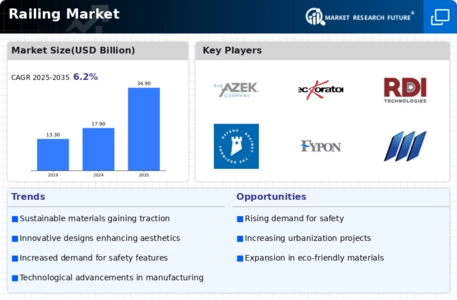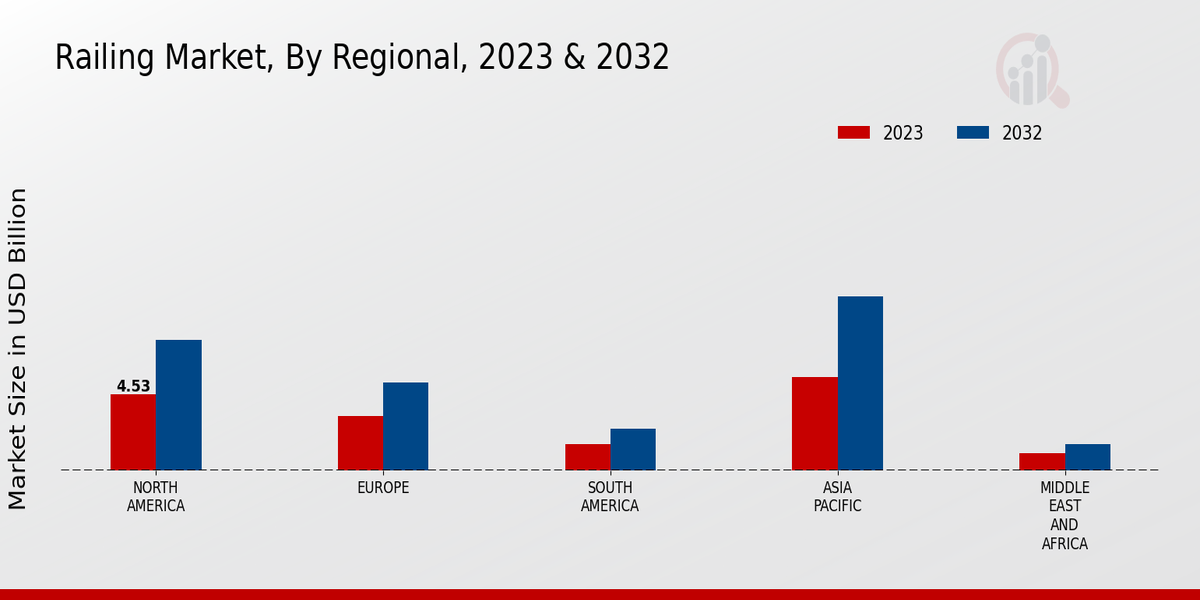Regulatory Compliance
The Global Railing Market Industry is significantly influenced by stringent safety regulations and building codes that mandate the installation of railings in various structures. Governments worldwide enforce these regulations to ensure public safety, particularly in high-rise buildings, public spaces, and residential areas. Compliance with these regulations often requires the use of specific materials and designs, which can drive innovation within the market. As a result, manufacturers are increasingly focusing on producing railings that meet these standards while also appealing to consumer preferences. This regulatory landscape is likely to contribute to the market's growth, with a projected CAGR of 6.22% from 2025 to 2035.
Sustainability Trends
Sustainability trends are becoming increasingly relevant in the Global Railing Market Industry. As environmental concerns rise, consumers and builders are gravitating towards eco-friendly materials and sustainable manufacturing practices. Railings made from recycled materials or sustainably sourced wood are gaining popularity, reflecting a broader shift towards green building practices. This trend not only aligns with consumer values but also meets regulatory requirements for sustainability in construction. Manufacturers are thus incentivized to innovate and adopt sustainable practices, which may enhance their market competitiveness. The growing emphasis on sustainability is expected to support the market's expansion, contributing to a projected CAGR of 6.22% from 2025 to 2035.
Increasing Urbanization
The Global Railing Market Industry experiences a notable boost due to the rapid urbanization occurring worldwide. As cities expand, the demand for residential and commercial buildings rises, necessitating the installation of railings for safety and aesthetic purposes. In 2024, the market is valued at approximately 17.9 USD Billion, reflecting the growing need for secure structures in urban environments. Railings serve not only as safety features but also as design elements that enhance the overall appeal of buildings. This trend is expected to continue, with projections indicating a market growth to 34.9 USD Billion by 2035, driven by urban development initiatives.
Market Growth Projections
The Global Railing Market Industry is poised for substantial growth, with projections indicating a market value of 17.9 USD Billion in 2024 and an anticipated increase to 34.9 USD Billion by 2035. This growth trajectory suggests a robust demand for railings across various sectors, including residential, commercial, and industrial applications. Factors such as urbanization, regulatory compliance, and consumer preferences for aesthetics and sustainability are likely to drive this expansion. The market is expected to experience a compound annual growth rate of 6.22% from 2025 to 2035, reflecting the increasing importance of railings in modern construction and design.
Technological Advancements
Technological advancements play a crucial role in shaping the Global Railing Market Industry. Innovations in materials, such as the development of lightweight yet durable composites, enhance the performance and aesthetic appeal of railings. Additionally, advancements in manufacturing processes, including automated production techniques, allow for greater customization and efficiency. These technological improvements not only reduce costs but also enable manufacturers to meet diverse consumer demands. As the market evolves, the integration of smart technologies, such as sensor-equipped railings for safety monitoring, may further drive growth. This trend aligns with the overall market trajectory, which is expected to reach 34.9 USD Billion by 2035.
Aesthetic Appeal and Customization
The Global Railing Market Industry is increasingly driven by consumer preferences for aesthetic appeal and customization options. Homeowners and builders are seeking railings that not only provide safety but also enhance the visual appeal of their properties. This demand has led to a rise in the availability of various designs, materials, and finishes, allowing for personalized solutions. Manufacturers are responding by offering customizable options that cater to specific architectural styles and individual tastes. This focus on aesthetics is likely to contribute to the market's growth, as consumers prioritize design alongside functionality. The market's value is projected to grow significantly, reaching 34.9 USD Billion by 2035.











